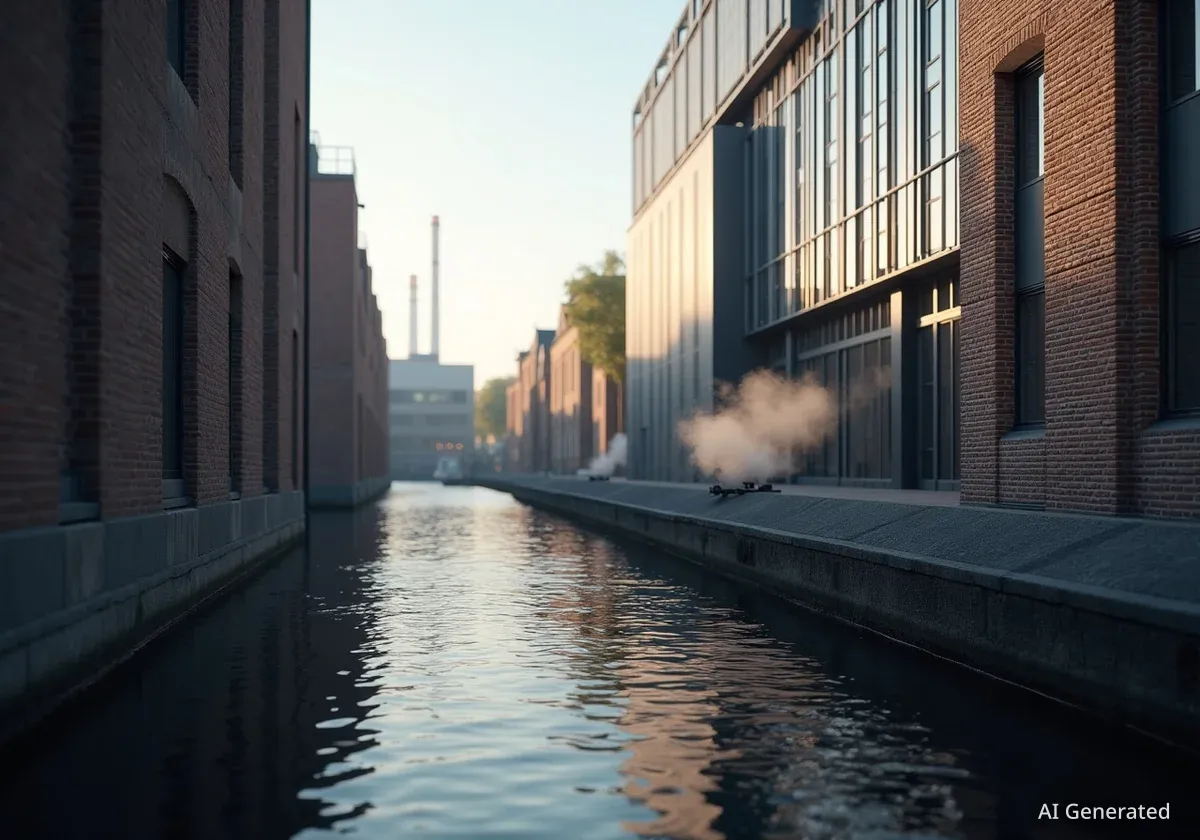A new energy centre on Liverpool's waterfront is using water from the historic Leeds Liverpool Canal to provide low-carbon heating to major buildings, including the Cunard Building and the Museum of Liverpool. The Mersey Heat Energy Centre, now officially open at Liverpool Waters, represents a significant step in the city's strategy to reduce carbon emissions.
The system utilizes advanced water source heat pumps housed within a restored Victorian-era pump house. This innovative approach merges industrial heritage with modern green technology to create a highly efficient district heating network, a model the UK government supports for achieving national net-zero targets.
Key Takeaways
- The new Mersey Heat Energy Centre at Liverpool Waters is now operational.
- It uses water from the Leeds Liverpool Canal to generate low-carbon heat and hot water.
- The network serves Liverpool Waters and is expanding to include the Cunard Building, Museum of Liverpool, and George's Dock Building.
- The technology is up to three times more efficient than standard electric heating and can cut carbon emissions by 90%.
- The project is a key part of Liverpool's plan to achieve net-zero carbon emissions.
A New Era of Energy on the Waterfront
Liverpool has officially launched its new Mersey Heat Energy Centre, a multi-million-pound facility designed to provide sustainable heating for the city's expanding waterfront. The centre marks a pivotal moment in the Liverpool Waters development, harnessing a piece of the city's industrial past to power its low-carbon future.
Located at Princes Dock, the project revives a Victorian Pump House, equipping it with modern heat pumps. This technology extracts latent heat from the waters of the Leeds Liverpool Canal, a waterway that was central to the Industrial Revolution when construction began in 1770.
From Industrial Past to Green Future
The Leeds Liverpool Canal was once a vital artery for transporting coal, textiles, and other goods. Today, the same waterway is being repurposed as a renewable energy source, demonstrating how historic infrastructure can be adapted to meet modern environmental challenges.
How Canal Water Powers Modern Buildings
The core of the Mersey Heat system is its use of water source heat pumps. These devices function by absorbing low-grade heat from the canal water and compressing it to raise its temperature. This heated water is then distributed through a network of insulated underground pipes to connected buildings for heating and hot water.
Efficiency and Environmental Impact
According to industry data, water source heat pumps are remarkably efficient. They are capable of producing around three units of heat for every one unit of electricity consumed, making them three times more efficient than traditional electric heating systems. This efficiency has the potential to reduce carbon emissions from heating by up to 90% compared to conventional gas boilers.
This method of creating a 'district heat network' is common in Scandinavian countries like Denmark and is strongly advocated by the UK Government. It is considered one of the most effective ways to decarbonise heating in dense urban areas, reducing reliance on fossil fuels one building at a time.
Expanding Network Connects Iconic Landmarks
While the initial vision for the Mersey Heat network was to serve the new developments within Liverpool Waters, its scope has already expanded significantly. The network is already supplying heat to the Torus’ Hartley Locks residential development, the Titanic Hotel, and the apartments at the historic Tobacco Warehouse.
A major expansion was made possible after Liverpool City Council secured £1.6 million from the Public Sector Decarbonisation Scheme. This funding is enabling the connection of three iconic municipal buildings to the network:
- The Cunard Building (City Council Headquarters)
- The George’s Dock Building
- The Museum of Liverpool
By joining the network, these landmark buildings can transition away from their existing gas-fired heating systems, leading to a substantial reduction in their carbon footprint. The system will also link with a similar heat network at the Royal Albert Dock, creating a more extensive and resilient energy system for the waterfront.
A Key Part of Liverpool's Net Zero Ambition
The official opening of the energy centre was marked as a significant achievement for the city's environmental goals. Leaders have hailed the project as a tangible example of Liverpool's commitment to tackling climate change and investing in a green economy.
“The launch of the Mersey Heat Energy Centre is a landmark moment in Liverpool’s journey towards a cleaner, greener future,” said Cllr Liam Robinson, leader of Liverpool City Council. “It is a visible example of how Liverpool is leading the way on low carbon infrastructure, protecting historic buildings, cutting emissions and creating long term green value for our communities.”
Cllr Robinson also emphasized the project's role in job creation and building a sustainable legacy. “I’m proud to see this vision and investment come to life, creating jobs in the emerging green economy,” he added.
The project was delivered through a partnership between Ener-Vate, the district heat network specialist for Peel, and Vital Energi, which served as the contractor responsible for the design, construction, operation, and maintenance of the facility.
The Future of Heat Networks in Liverpool
The Mersey Heat Energy Centre is just the beginning of a wider strategy for Liverpool. The city council is an active participant in the Department for Energy Security and Net Zero (DESNZ) Advanced Zoning Programme. This national initiative aims to identify and develop areas suitable for heat networks across the country.
As part of this programme, the council plans to seek a 'Zone Developer' before the end of the financial year. This partner will be tasked with rolling out further district heat networks across different parts of Liverpool, scaling up the benefits seen on the waterfront.
This long-term vision positions Liverpool as a leader in deploying low-carbon infrastructure, using its unique geography and industrial heritage as assets in the transition to a sustainable future.





